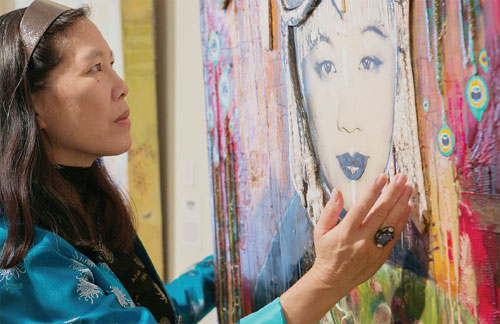'Lost' movie brings home horror of occupation
By Tan Yingzi (China Daily) Updated: 2015-08-18 07:36|
Robin Lung discovered Kukan, a long-lost Oscar-winning documentary, when she began researching the life of Li Ling-Ai (pictured), a Chinese-American playwright from Hawaii, for a proposed movie. Kukan is described as "the most complete record of the Japanese invasion of China by a Westerner". Photos Provided to China Daily |
A unique documentary about the 1937 invasion of China recently had its first screening in the country, more than 70 years after it alerted the world to the brutality of life under the Japanese and won an Academy Award. Tan Yingzi reports from Chongqing.
Zhou Yong will always remember the day he signed an agreement to bring a long-lost 1941 Oscar-winning documentary to China for the first time. "It's the most complete record of the Japanese invasion of China by a Westerner. Every viewer will be deeply touched and shocked by the struggles ordinary Chinese people faced through-out the war," he said.
Kukan was officially classified as "lost" for almost 70 years, but a print was unearthed in 2009, and restoration work, which began in 2010, is still not finished. However, a VHS copy of the movie was finally screened in China in July at a seminar held in Chongqing, the country's wartime capital.
On April 3, Zhou, director of the Research Center for the Anti-Japanese War in the Unoccupied Area in Chongqing, signed an agreement with the family of the late Rey Scott, who shot and narrated the movie, to purchase the rights to screen Kukan for use by researchers and in public education.
The documentary, co-produced and sponsored between 1937 and 1940 by Li Ling-Ai, a Chinese-American playwright, is the only color film about life in occupied China. It records the struggles and sacrifices of the Chinese people during the early years of the War of Resistance against Japanese Aggression (1937-45).
Kukan means "hard working", a quality Li believed helped the Chinese people beat the Japanese occupiers. The movie caused a sensation when it premiered in New York on June 23, 1941, and was reviewed by media in the US and across the world, including The New York Times, the Chicago Daily Times, Time magazine and The Daily Telegraph in London. President Franklin D. Roosevelt saw it at a private screening at the White House, and the 85-minute movie - subtitled The Secret of Unconquerable China - was awarded an honorary Oscar by the US Academy of Motion Picture Arts and Sciences.
After the war, Kukan faded from view, and was officially classified as "lost" by the academy. There was no sighting of it until six years ago when RobinLung, a Chinese-American movie producer, discovered a copy in the basement of a house belonging to one of Scott's descendents.
In April 2010, the academy started work to restore the 16mm print, and Lung is now in the final stages of making Finding Kukan, a documentary about the movie's rediscovery and its creators.
East meets West
In 1937, when Japan invaded China, Li decided she had a mission to bring the plight of Chinese people to the world's attention. She pawned her grandmother's jewelry to fund a movie and hired Scott, a photojournalist from the US midwest, to travel around China and document whatever he saw.
Born in Hawaii on May 19, 1908, Li was the sixth of nine children. She grew up in an unconventional household - in the late 1800s, her parents were among the first Chinese physicians to practice Western medicine in Hawaii - and she lived in China in the early 1930s, according to Lung.
"Ling-Ai was the epitome of East meets West. She was given a classic Western education at the prestigious Punahou School (also US President Barack Obama's alma mater) while learning Chinese language, dance and music from Chinese Imperial Court scholars at Mun Lun," Lung wrote on a website she set up to promote Kukan.
Scott made four hazardous trips to China between 1937 and 1940, traveling extensively-from Shanghai and Nanjing to the southern parts of the provinces of Yunnan and Guangdong, plus the Gobi Desert and Chongqing - and using a 16mm motion picture camera and the most advanced color film to capture ordinary lives and the battle against the Japanese.
"Legend says 300 steps lead up to Chongqing, so I counted them. It's 340 steps," Scott says in the narration, describing how he excitedly rode a horse up the steps of Chaotianmen Pier in Chongqing.
- Company 'dealing' with chemicals at blast site
- Real estate firm's chief says lessons have been learned from disaster
- City vows to monitor pollution
- Toxic chemical cleanup underway
- Beijing among most polluted cities for first time this year
- 114 people confirmed killed in Tianjin blasts, 70 remain missing
- Pollution rules aim at accountability measures
- Port operations return to normal after Tianjin blasts
- Li pledges thorough investigation
- 'Nobody told us there were chemicals here'








